Restaurant Design and Conceptualisation: Understanding the Viability of Nose to Tail Concept in Cattle Class Oriented Restaurant
VerifiedAdded on 2023/06/10
|8
|2306
|138
AI Summary
This research aims to understand the concept and viability of Nose to tail concept of restaurant Cattle class Oriented. Findings suggest that the nose to tail dining is a concept in the food culture that resembles one of the old trends. The restaurant design which will use the nose to tail way of dinning will be having a authentic form of structure and design. The concept which is chosen by this organization is considered to be ethically sustainable however, the killing of animals for consumption has been a ethical issue of sustainability for decades.
Contribute Materials
Your contribution can guide someone’s learning journey. Share your
documents today.

Restaurant design and
conceptualisation
conceptualisation
Secure Best Marks with AI Grader
Need help grading? Try our AI Grader for instant feedback on your assignments.
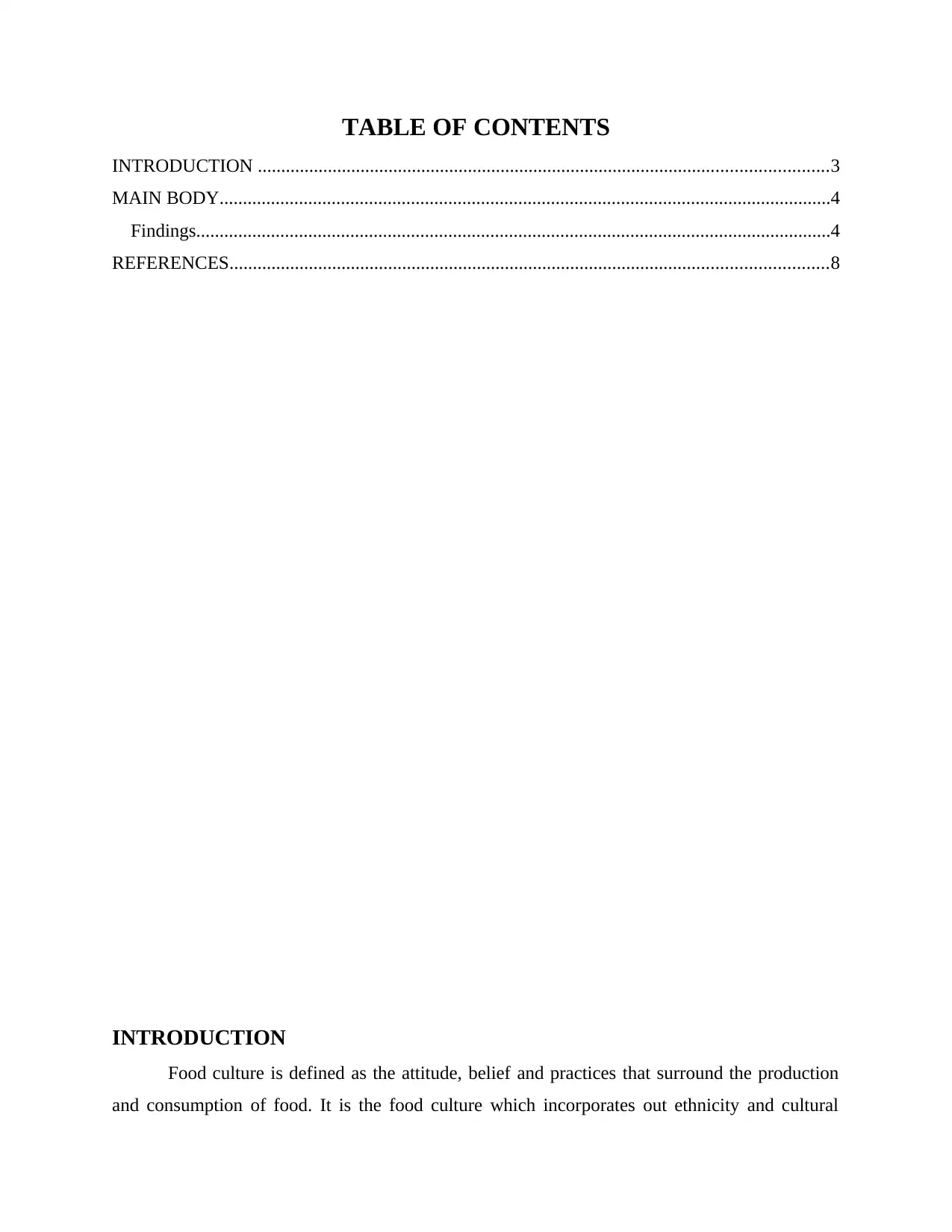
TABLE OF CONTENTS
INTRODUCTION ..........................................................................................................................3
MAIN BODY...................................................................................................................................4
Findings........................................................................................................................................4
REFERENCES................................................................................................................................8
INTRODUCTION
Food culture is defined as the attitude, belief and practices that surround the production
and consumption of food. It is the food culture which incorporates out ethnicity and cultural
INTRODUCTION ..........................................................................................................................3
MAIN BODY...................................................................................................................................4
Findings........................................................................................................................................4
REFERENCES................................................................................................................................8
INTRODUCTION
Food culture is defined as the attitude, belief and practices that surround the production
and consumption of food. It is the food culture which incorporates out ethnicity and cultural
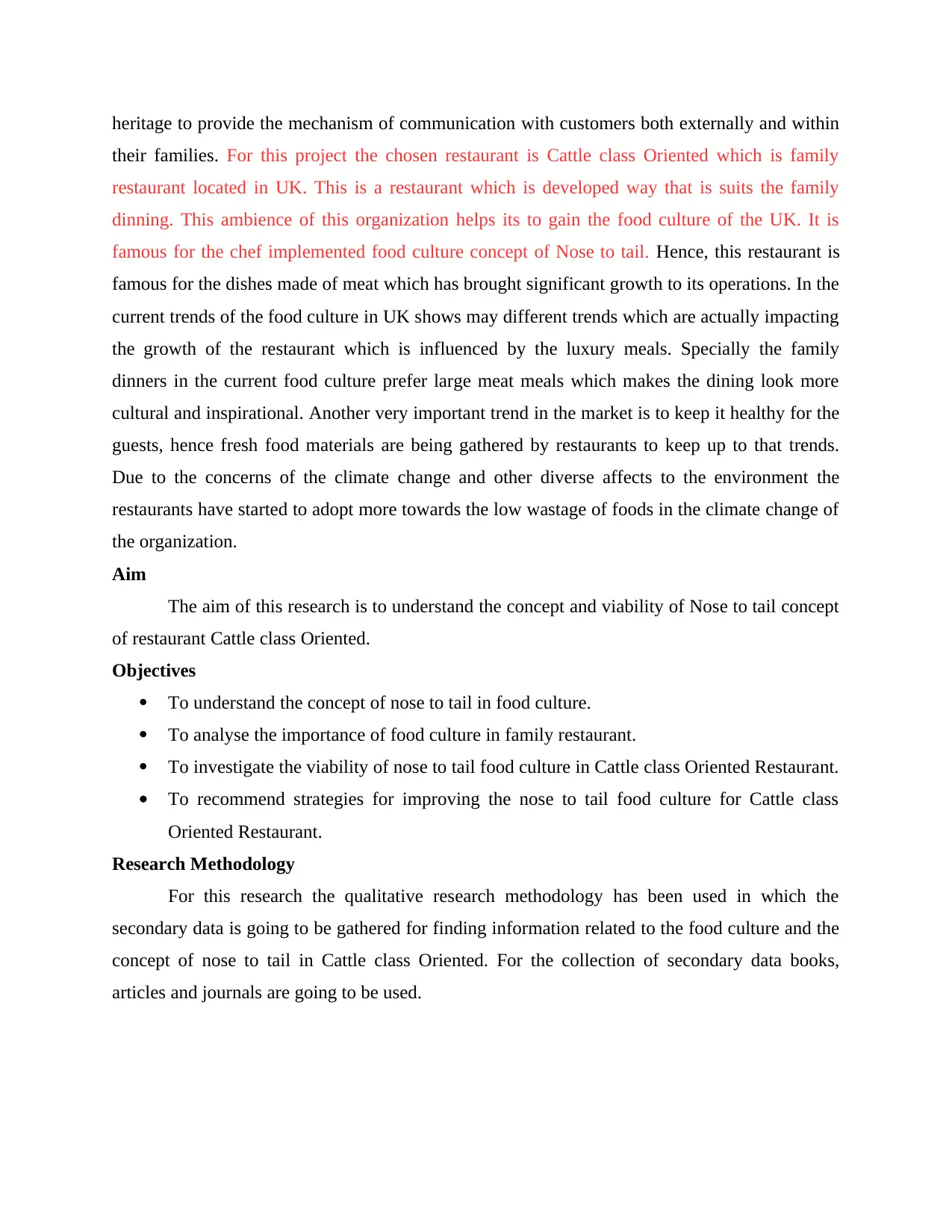
heritage to provide the mechanism of communication with customers both externally and within
their families. For this project the chosen restaurant is Cattle class Oriented which is family
restaurant located in UK. This is a restaurant which is developed way that is suits the family
dinning. This ambience of this organization helps its to gain the food culture of the UK. It is
famous for the chef implemented food culture concept of Nose to tail. Hence, this restaurant is
famous for the dishes made of meat which has brought significant growth to its operations. In the
current trends of the food culture in UK shows may different trends which are actually impacting
the growth of the restaurant which is influenced by the luxury meals. Specially the family
dinners in the current food culture prefer large meat meals which makes the dining look more
cultural and inspirational. Another very important trend in the market is to keep it healthy for the
guests, hence fresh food materials are being gathered by restaurants to keep up to that trends.
Due to the concerns of the climate change and other diverse affects to the environment the
restaurants have started to adopt more towards the low wastage of foods in the climate change of
the organization.
Aim
The aim of this research is to understand the concept and viability of Nose to tail concept
of restaurant Cattle class Oriented.
Objectives
To understand the concept of nose to tail in food culture.
To analyse the importance of food culture in family restaurant.
To investigate the viability of nose to tail food culture in Cattle class Oriented Restaurant.
To recommend strategies for improving the nose to tail food culture for Cattle class
Oriented Restaurant.
Research Methodology
For this research the qualitative research methodology has been used in which the
secondary data is going to be gathered for finding information related to the food culture and the
concept of nose to tail in Cattle class Oriented. For the collection of secondary data books,
articles and journals are going to be used.
their families. For this project the chosen restaurant is Cattle class Oriented which is family
restaurant located in UK. This is a restaurant which is developed way that is suits the family
dinning. This ambience of this organization helps its to gain the food culture of the UK. It is
famous for the chef implemented food culture concept of Nose to tail. Hence, this restaurant is
famous for the dishes made of meat which has brought significant growth to its operations. In the
current trends of the food culture in UK shows may different trends which are actually impacting
the growth of the restaurant which is influenced by the luxury meals. Specially the family
dinners in the current food culture prefer large meat meals which makes the dining look more
cultural and inspirational. Another very important trend in the market is to keep it healthy for the
guests, hence fresh food materials are being gathered by restaurants to keep up to that trends.
Due to the concerns of the climate change and other diverse affects to the environment the
restaurants have started to adopt more towards the low wastage of foods in the climate change of
the organization.
Aim
The aim of this research is to understand the concept and viability of Nose to tail concept
of restaurant Cattle class Oriented.
Objectives
To understand the concept of nose to tail in food culture.
To analyse the importance of food culture in family restaurant.
To investigate the viability of nose to tail food culture in Cattle class Oriented Restaurant.
To recommend strategies for improving the nose to tail food culture for Cattle class
Oriented Restaurant.
Research Methodology
For this research the qualitative research methodology has been used in which the
secondary data is going to be gathered for finding information related to the food culture and the
concept of nose to tail in Cattle class Oriented. For the collection of secondary data books,
articles and journals are going to be used.
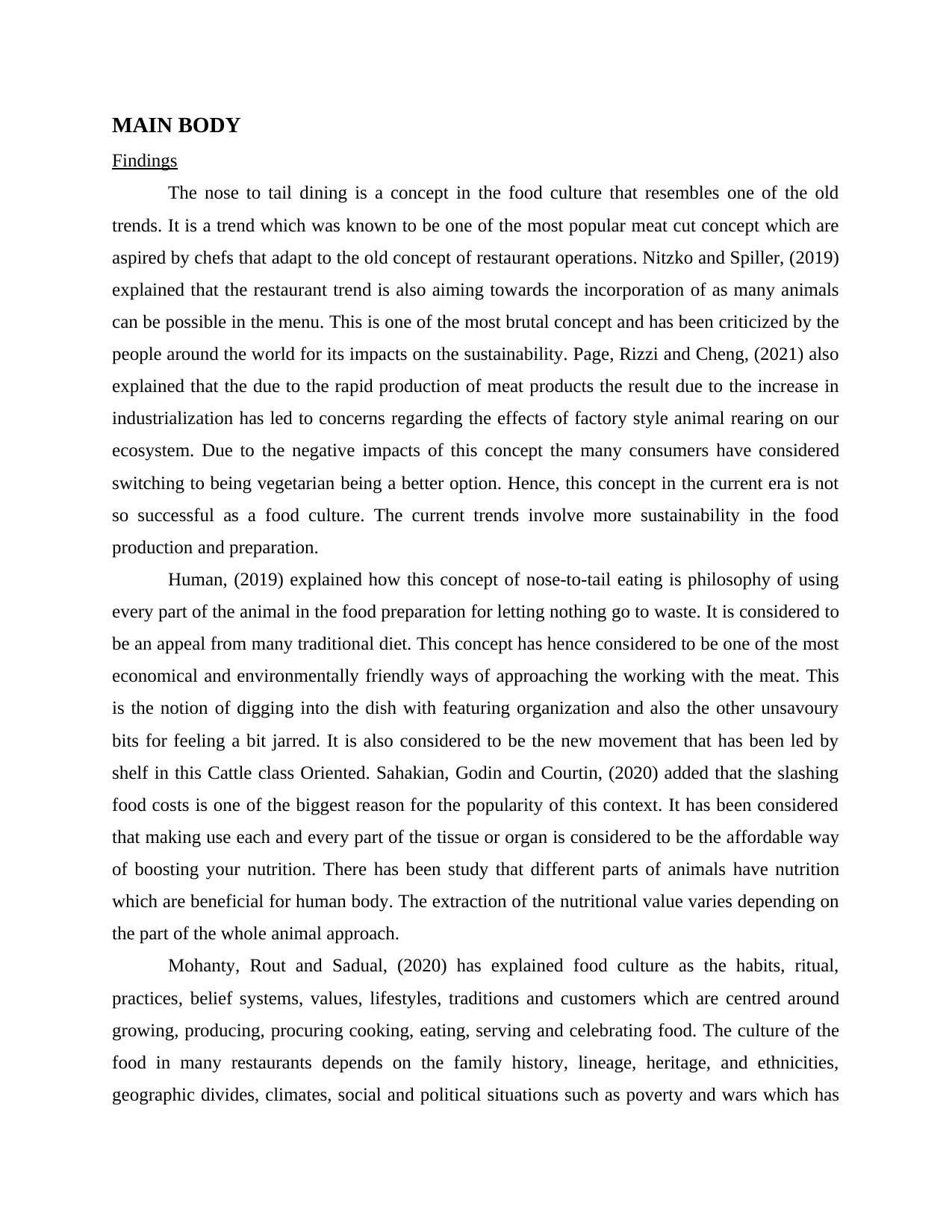
MAIN BODY
Findings
The nose to tail dining is a concept in the food culture that resembles one of the old
trends. It is a trend which was known to be one of the most popular meat cut concept which are
aspired by chefs that adapt to the old concept of restaurant operations. Nitzko and Spiller, (2019)
explained that the restaurant trend is also aiming towards the incorporation of as many animals
can be possible in the menu. This is one of the most brutal concept and has been criticized by the
people around the world for its impacts on the sustainability. Page, Rizzi and Cheng, (2021) also
explained that the due to the rapid production of meat products the result due to the increase in
industrialization has led to concerns regarding the effects of factory style animal rearing on our
ecosystem. Due to the negative impacts of this concept the many consumers have considered
switching to being vegetarian being a better option. Hence, this concept in the current era is not
so successful as a food culture. The current trends involve more sustainability in the food
production and preparation.
Human, (2019) explained how this concept of nose-to-tail eating is philosophy of using
every part of the animal in the food preparation for letting nothing go to waste. It is considered to
be an appeal from many traditional diet. This concept has hence considered to be one of the most
economical and environmentally friendly ways of approaching the working with the meat. This
is the notion of digging into the dish with featuring organization and also the other unsavoury
bits for feeling a bit jarred. It is also considered to be the new movement that has been led by
shelf in this Cattle class Oriented. Sahakian, Godin and Courtin, (2020) added that the slashing
food costs is one of the biggest reason for the popularity of this context. It has been considered
that making use each and every part of the tissue or organ is considered to be the affordable way
of boosting your nutrition. There has been study that different parts of animals have nutrition
which are beneficial for human body. The extraction of the nutritional value varies depending on
the part of the whole animal approach.
Mohanty, Rout and Sadual, (2020) has explained food culture as the habits, ritual,
practices, belief systems, values, lifestyles, traditions and customers which are centred around
growing, producing, procuring cooking, eating, serving and celebrating food. The culture of the
food in many restaurants depends on the family history, lineage, heritage, and ethnicities,
geographic divides, climates, social and political situations such as poverty and wars which has
Findings
The nose to tail dining is a concept in the food culture that resembles one of the old
trends. It is a trend which was known to be one of the most popular meat cut concept which are
aspired by chefs that adapt to the old concept of restaurant operations. Nitzko and Spiller, (2019)
explained that the restaurant trend is also aiming towards the incorporation of as many animals
can be possible in the menu. This is one of the most brutal concept and has been criticized by the
people around the world for its impacts on the sustainability. Page, Rizzi and Cheng, (2021) also
explained that the due to the rapid production of meat products the result due to the increase in
industrialization has led to concerns regarding the effects of factory style animal rearing on our
ecosystem. Due to the negative impacts of this concept the many consumers have considered
switching to being vegetarian being a better option. Hence, this concept in the current era is not
so successful as a food culture. The current trends involve more sustainability in the food
production and preparation.
Human, (2019) explained how this concept of nose-to-tail eating is philosophy of using
every part of the animal in the food preparation for letting nothing go to waste. It is considered to
be an appeal from many traditional diet. This concept has hence considered to be one of the most
economical and environmentally friendly ways of approaching the working with the meat. This
is the notion of digging into the dish with featuring organization and also the other unsavoury
bits for feeling a bit jarred. It is also considered to be the new movement that has been led by
shelf in this Cattle class Oriented. Sahakian, Godin and Courtin, (2020) added that the slashing
food costs is one of the biggest reason for the popularity of this context. It has been considered
that making use each and every part of the tissue or organ is considered to be the affordable way
of boosting your nutrition. There has been study that different parts of animals have nutrition
which are beneficial for human body. The extraction of the nutritional value varies depending on
the part of the whole animal approach.
Mohanty, Rout and Sadual, (2020) has explained food culture as the habits, ritual,
practices, belief systems, values, lifestyles, traditions and customers which are centred around
growing, producing, procuring cooking, eating, serving and celebrating food. The culture of the
food in many restaurants depends on the family history, lineage, heritage, and ethnicities,
geographic divides, climates, social and political situations such as poverty and wars which has
Secure Best Marks with AI Grader
Need help grading? Try our AI Grader for instant feedback on your assignments.
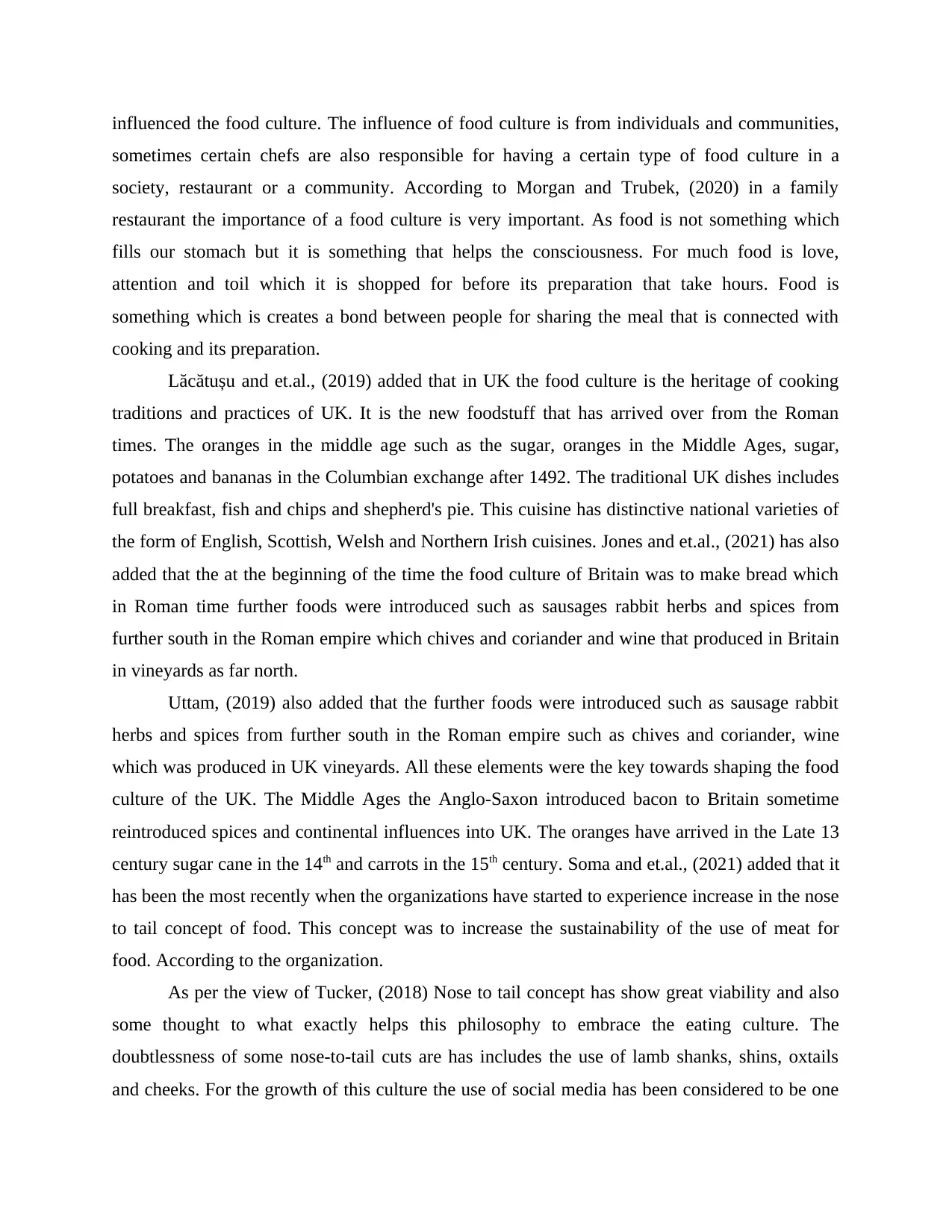
influenced the food culture. The influence of food culture is from individuals and communities,
sometimes certain chefs are also responsible for having a certain type of food culture in a
society, restaurant or a community. According to Morgan and Trubek, (2020) in a family
restaurant the importance of a food culture is very important. As food is not something which
fills our stomach but it is something that helps the consciousness. For much food is love,
attention and toil which it is shopped for before its preparation that take hours. Food is
something which is creates a bond between people for sharing the meal that is connected with
cooking and its preparation.
Lăcătușu and et.al., (2019) added that in UK the food culture is the heritage of cooking
traditions and practices of UK. It is the new foodstuff that has arrived over from the Roman
times. The oranges in the middle age such as the sugar, oranges in the Middle Ages, sugar,
potatoes and bananas in the Columbian exchange after 1492. The traditional UK dishes includes
full breakfast, fish and chips and shepherd's pie. This cuisine has distinctive national varieties of
the form of English, Scottish, Welsh and Northern Irish cuisines. Jones and et.al., (2021) has also
added that the at the beginning of the time the food culture of Britain was to make bread which
in Roman time further foods were introduced such as sausages rabbit herbs and spices from
further south in the Roman empire which chives and coriander and wine that produced in Britain
in vineyards as far north.
Uttam, (2019) also added that the further foods were introduced such as sausage rabbit
herbs and spices from further south in the Roman empire such as chives and coriander, wine
which was produced in UK vineyards. All these elements were the key towards shaping the food
culture of the UK. The Middle Ages the Anglo-Saxon introduced bacon to Britain sometime
reintroduced spices and continental influences into UK. The oranges have arrived in the Late 13
century sugar cane in the 14th and carrots in the 15th century. Soma and et.al., (2021) added that it
has been the most recently when the organizations have started to experience increase in the nose
to tail concept of food. This concept was to increase the sustainability of the use of meat for
food. According to the organization.
As per the view of Tucker, (2018) Nose to tail concept has show great viability and also
some thought to what exactly helps this philosophy to embrace the eating culture. The
doubtlessness of some nose-to-tail cuts are has includes the use of lamb shanks, shins, oxtails
and cheeks. For the growth of this culture the use of social media has been considered to be one
sometimes certain chefs are also responsible for having a certain type of food culture in a
society, restaurant or a community. According to Morgan and Trubek, (2020) in a family
restaurant the importance of a food culture is very important. As food is not something which
fills our stomach but it is something that helps the consciousness. For much food is love,
attention and toil which it is shopped for before its preparation that take hours. Food is
something which is creates a bond between people for sharing the meal that is connected with
cooking and its preparation.
Lăcătușu and et.al., (2019) added that in UK the food culture is the heritage of cooking
traditions and practices of UK. It is the new foodstuff that has arrived over from the Roman
times. The oranges in the middle age such as the sugar, oranges in the Middle Ages, sugar,
potatoes and bananas in the Columbian exchange after 1492. The traditional UK dishes includes
full breakfast, fish and chips and shepherd's pie. This cuisine has distinctive national varieties of
the form of English, Scottish, Welsh and Northern Irish cuisines. Jones and et.al., (2021) has also
added that the at the beginning of the time the food culture of Britain was to make bread which
in Roman time further foods were introduced such as sausages rabbit herbs and spices from
further south in the Roman empire which chives and coriander and wine that produced in Britain
in vineyards as far north.
Uttam, (2019) also added that the further foods were introduced such as sausage rabbit
herbs and spices from further south in the Roman empire such as chives and coriander, wine
which was produced in UK vineyards. All these elements were the key towards shaping the food
culture of the UK. The Middle Ages the Anglo-Saxon introduced bacon to Britain sometime
reintroduced spices and continental influences into UK. The oranges have arrived in the Late 13
century sugar cane in the 14th and carrots in the 15th century. Soma and et.al., (2021) added that it
has been the most recently when the organizations have started to experience increase in the nose
to tail concept of food. This concept was to increase the sustainability of the use of meat for
food. According to the organization.
As per the view of Tucker, (2018) Nose to tail concept has show great viability and also
some thought to what exactly helps this philosophy to embrace the eating culture. The
doubtlessness of some nose-to-tail cuts are has includes the use of lamb shanks, shins, oxtails
and cheeks. For the growth of this culture the use of social media has been considered to be one
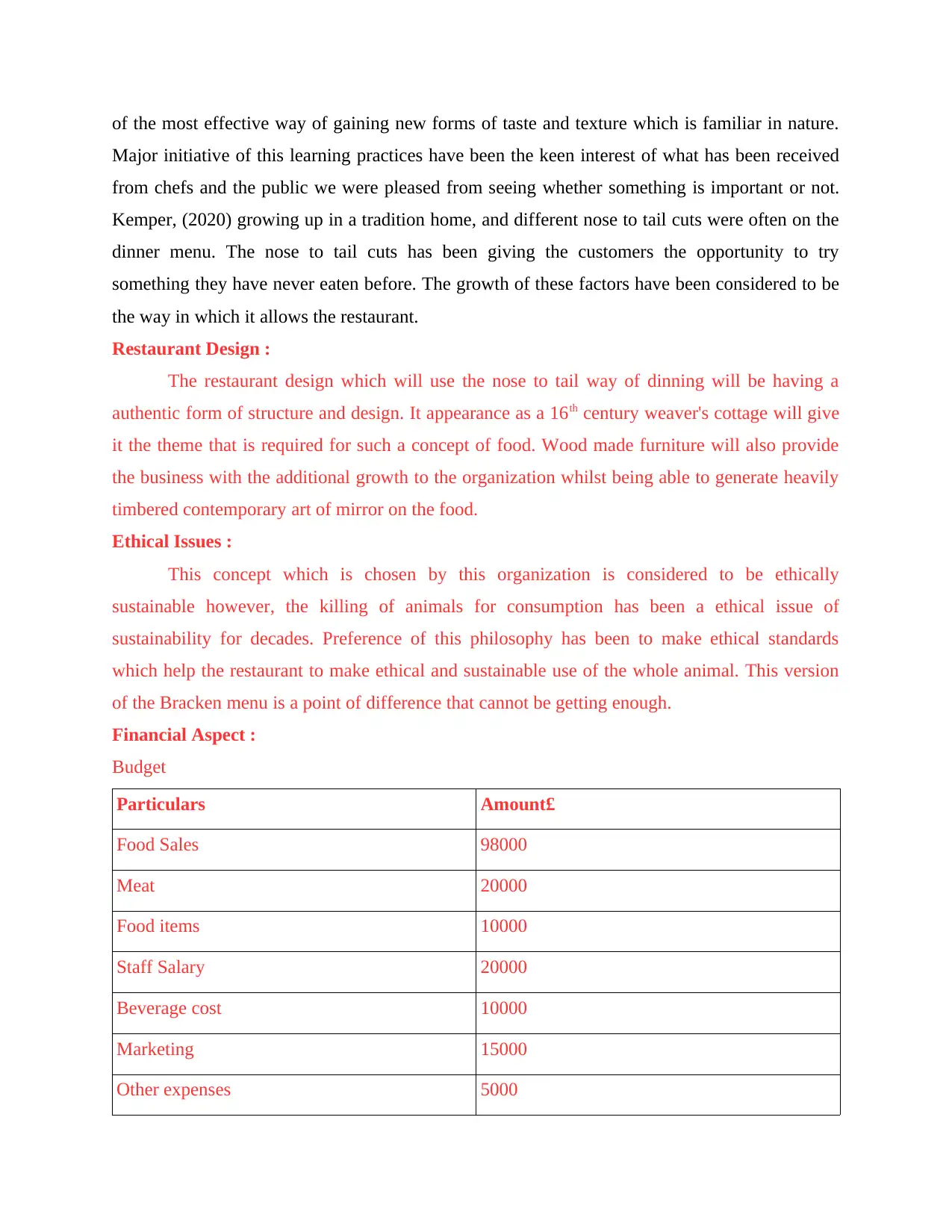
of the most effective way of gaining new forms of taste and texture which is familiar in nature.
Major initiative of this learning practices have been the keen interest of what has been received
from chefs and the public we were pleased from seeing whether something is important or not.
Kemper, (2020) growing up in a tradition home, and different nose to tail cuts were often on the
dinner menu. The nose to tail cuts has been giving the customers the opportunity to try
something they have never eaten before. The growth of these factors have been considered to be
the way in which it allows the restaurant.
Restaurant Design :
The restaurant design which will use the nose to tail way of dinning will be having a
authentic form of structure and design. It appearance as a 16th century weaver's cottage will give
it the theme that is required for such a concept of food. Wood made furniture will also provide
the business with the additional growth to the organization whilst being able to generate heavily
timbered contemporary art of mirror on the food.
Ethical Issues :
This concept which is chosen by this organization is considered to be ethically
sustainable however, the killing of animals for consumption has been a ethical issue of
sustainability for decades. Preference of this philosophy has been to make ethical standards
which help the restaurant to make ethical and sustainable use of the whole animal. This version
of the Bracken menu is a point of difference that cannot be getting enough.
Financial Aspect :
Budget
Particulars Amount£
Food Sales 98000
Meat 20000
Food items 10000
Staff Salary 20000
Beverage cost 10000
Marketing 15000
Other expenses 5000
Major initiative of this learning practices have been the keen interest of what has been received
from chefs and the public we were pleased from seeing whether something is important or not.
Kemper, (2020) growing up in a tradition home, and different nose to tail cuts were often on the
dinner menu. The nose to tail cuts has been giving the customers the opportunity to try
something they have never eaten before. The growth of these factors have been considered to be
the way in which it allows the restaurant.
Restaurant Design :
The restaurant design which will use the nose to tail way of dinning will be having a
authentic form of structure and design. It appearance as a 16th century weaver's cottage will give
it the theme that is required for such a concept of food. Wood made furniture will also provide
the business with the additional growth to the organization whilst being able to generate heavily
timbered contemporary art of mirror on the food.
Ethical Issues :
This concept which is chosen by this organization is considered to be ethically
sustainable however, the killing of animals for consumption has been a ethical issue of
sustainability for decades. Preference of this philosophy has been to make ethical standards
which help the restaurant to make ethical and sustainable use of the whole animal. This version
of the Bracken menu is a point of difference that cannot be getting enough.
Financial Aspect :
Budget
Particulars Amount£
Food Sales 98000
Meat 20000
Food items 10000
Staff Salary 20000
Beverage cost 10000
Marketing 15000
Other expenses 5000
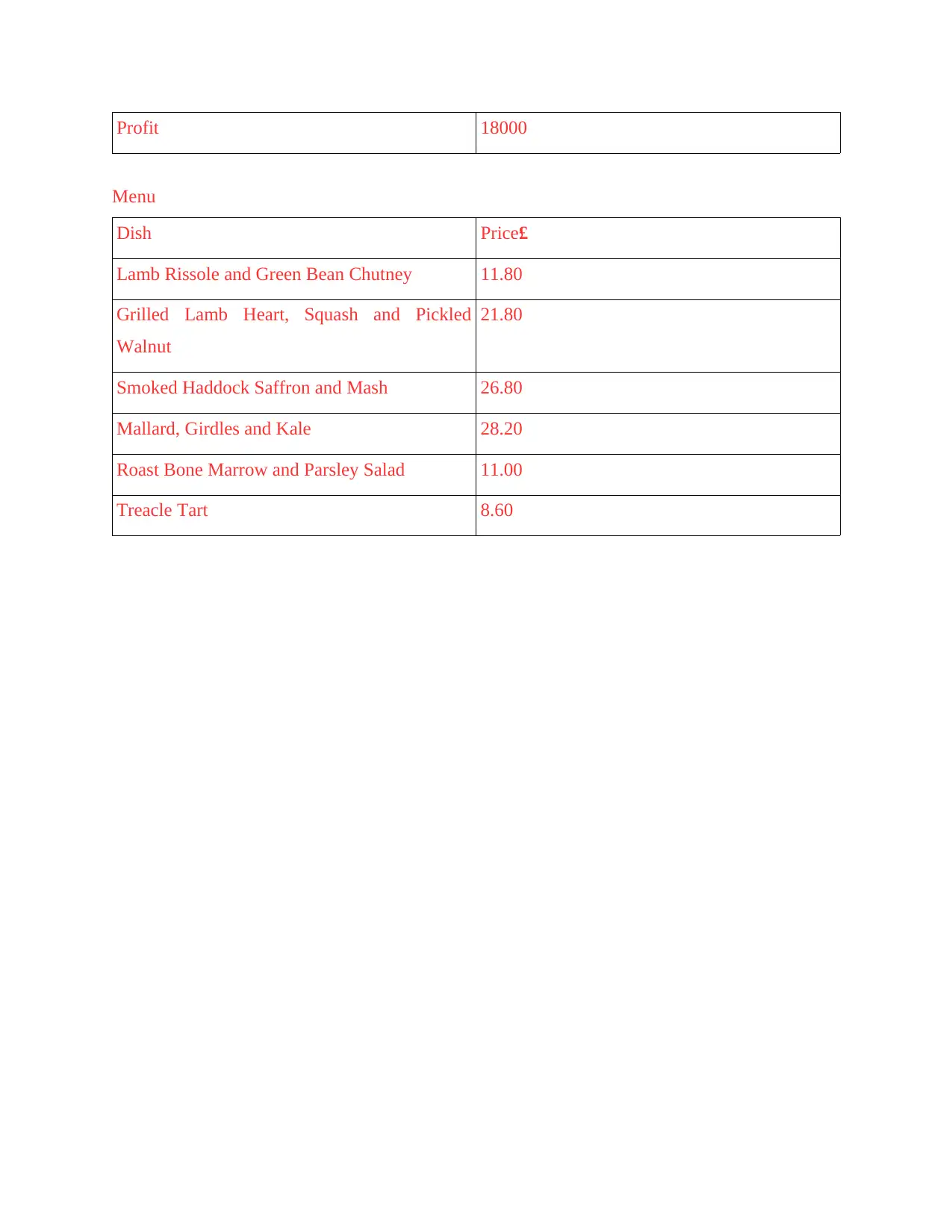
Profit 18000
Menu
Dish Price£
Lamb Rissole and Green Bean Chutney 11.80
Grilled Lamb Heart, Squash and Pickled
Walnut
21.80
Smoked Haddock Saffron and Mash 26.80
Mallard, Girdles and Kale 28.20
Roast Bone Marrow and Parsley Salad 11.00
Treacle Tart 8.60
Menu
Dish Price£
Lamb Rissole and Green Bean Chutney 11.80
Grilled Lamb Heart, Squash and Pickled
Walnut
21.80
Smoked Haddock Saffron and Mash 26.80
Mallard, Girdles and Kale 28.20
Roast Bone Marrow and Parsley Salad 11.00
Treacle Tart 8.60
Paraphrase This Document
Need a fresh take? Get an instant paraphrase of this document with our AI Paraphraser
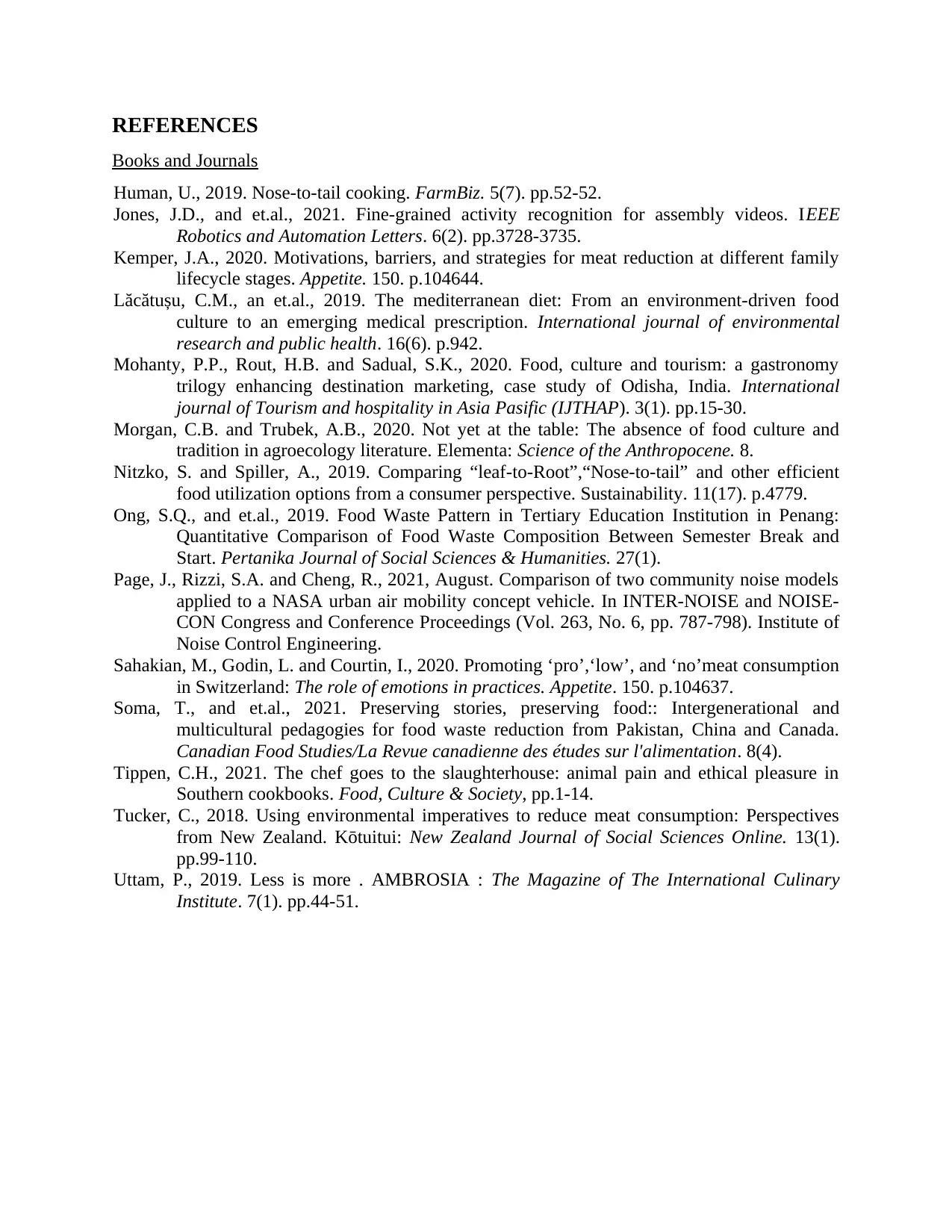
REFERENCES
Books and Journals
Human, U., 2019. Nose-to-tail cooking. FarmBiz. 5(7). pp.52-52.
Jones, J.D., and et.al., 2021. Fine-grained activity recognition for assembly videos. IEEE
Robotics and Automation Letters. 6(2). pp.3728-3735.
Kemper, J.A., 2020. Motivations, barriers, and strategies for meat reduction at different family
lifecycle stages. Appetite. 150. p.104644.
Lăcătușu, C.M., an et.al., 2019. The mediterranean diet: From an environment-driven food
culture to an emerging medical prescription. International journal of environmental
research and public health. 16(6). p.942.
Mohanty, P.P., Rout, H.B. and Sadual, S.K., 2020. Food, culture and tourism: a gastronomy
trilogy enhancing destination marketing, case study of Odisha, India. International
journal of Tourism and hospitality in Asia Pasific (IJTHAP). 3(1). pp.15-30.
Morgan, C.B. and Trubek, A.B., 2020. Not yet at the table: The absence of food culture and
tradition in agroecology literature. Elementa: Science of the Anthropocene. 8.
Nitzko, S. and Spiller, A., 2019. Comparing “leaf-to-Root”,“Nose-to-tail” and other efficient
food utilization options from a consumer perspective. Sustainability. 11(17). p.4779.
Ong, S.Q., and et.al., 2019. Food Waste Pattern in Tertiary Education Institution in Penang:
Quantitative Comparison of Food Waste Composition Between Semester Break and
Start. Pertanika Journal of Social Sciences & Humanities. 27(1).
Page, J., Rizzi, S.A. and Cheng, R., 2021, August. Comparison of two community noise models
applied to a NASA urban air mobility concept vehicle. In INTER-NOISE and NOISE-
CON Congress and Conference Proceedings (Vol. 263, No. 6, pp. 787-798). Institute of
Noise Control Engineering.
Sahakian, M., Godin, L. and Courtin, I., 2020. Promoting ‘pro’,‘low’, and ‘no’meat consumption
in Switzerland: The role of emotions in practices. Appetite. 150. p.104637.
Soma, T., and et.al., 2021. Preserving stories, preserving food:: Intergenerational and
multicultural pedagogies for food waste reduction from Pakistan, China and Canada.
Canadian Food Studies/La Revue canadienne des études sur l'alimentation. 8(4).
Tippen, C.H., 2021. The chef goes to the slaughterhouse: animal pain and ethical pleasure in
Southern cookbooks. Food, Culture & Society, pp.1-14.
Tucker, C., 2018. Using environmental imperatives to reduce meat consumption: Perspectives
from New Zealand. Kōtuitui: New Zealand Journal of Social Sciences Online. 13(1).
pp.99-110.
Uttam, P., 2019. Less is more . AMBROSIA : The Magazine of The International Culinary
Institute. 7(1). pp.44-51.
Books and Journals
Human, U., 2019. Nose-to-tail cooking. FarmBiz. 5(7). pp.52-52.
Jones, J.D., and et.al., 2021. Fine-grained activity recognition for assembly videos. IEEE
Robotics and Automation Letters. 6(2). pp.3728-3735.
Kemper, J.A., 2020. Motivations, barriers, and strategies for meat reduction at different family
lifecycle stages. Appetite. 150. p.104644.
Lăcătușu, C.M., an et.al., 2019. The mediterranean diet: From an environment-driven food
culture to an emerging medical prescription. International journal of environmental
research and public health. 16(6). p.942.
Mohanty, P.P., Rout, H.B. and Sadual, S.K., 2020. Food, culture and tourism: a gastronomy
trilogy enhancing destination marketing, case study of Odisha, India. International
journal of Tourism and hospitality in Asia Pasific (IJTHAP). 3(1). pp.15-30.
Morgan, C.B. and Trubek, A.B., 2020. Not yet at the table: The absence of food culture and
tradition in agroecology literature. Elementa: Science of the Anthropocene. 8.
Nitzko, S. and Spiller, A., 2019. Comparing “leaf-to-Root”,“Nose-to-tail” and other efficient
food utilization options from a consumer perspective. Sustainability. 11(17). p.4779.
Ong, S.Q., and et.al., 2019. Food Waste Pattern in Tertiary Education Institution in Penang:
Quantitative Comparison of Food Waste Composition Between Semester Break and
Start. Pertanika Journal of Social Sciences & Humanities. 27(1).
Page, J., Rizzi, S.A. and Cheng, R., 2021, August. Comparison of two community noise models
applied to a NASA urban air mobility concept vehicle. In INTER-NOISE and NOISE-
CON Congress and Conference Proceedings (Vol. 263, No. 6, pp. 787-798). Institute of
Noise Control Engineering.
Sahakian, M., Godin, L. and Courtin, I., 2020. Promoting ‘pro’,‘low’, and ‘no’meat consumption
in Switzerland: The role of emotions in practices. Appetite. 150. p.104637.
Soma, T., and et.al., 2021. Preserving stories, preserving food:: Intergenerational and
multicultural pedagogies for food waste reduction from Pakistan, China and Canada.
Canadian Food Studies/La Revue canadienne des études sur l'alimentation. 8(4).
Tippen, C.H., 2021. The chef goes to the slaughterhouse: animal pain and ethical pleasure in
Southern cookbooks. Food, Culture & Society, pp.1-14.
Tucker, C., 2018. Using environmental imperatives to reduce meat consumption: Perspectives
from New Zealand. Kōtuitui: New Zealand Journal of Social Sciences Online. 13(1).
pp.99-110.
Uttam, P., 2019. Less is more . AMBROSIA : The Magazine of The International Culinary
Institute. 7(1). pp.44-51.
1 out of 8
Your All-in-One AI-Powered Toolkit for Academic Success.
+13062052269
info@desklib.com
Available 24*7 on WhatsApp / Email
![[object Object]](/_next/static/media/star-bottom.7253800d.svg)
Unlock your academic potential
© 2024 | Zucol Services PVT LTD | All rights reserved.

